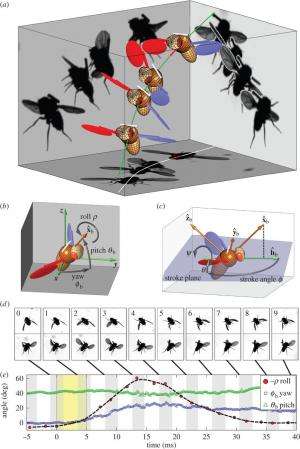Roll perturbation and correction. (a) Images from three orthogonal cameras of a roll correction manoeuvre. The three-dimensional-rendered fly represents the measured kinematics. The perturbation location (red line) is shown on the fly's centre-of-mass trajectory (green). In the second snapshot, the fly is rolled 60° to its left. (b) Definition of body Euler angles with respect to the laboratory frame. is the long body axis. (c) Definition of the body frame and wing Euler angles, measured in the body frame with respect to the stroke plane (shaded blue). (d) Top and side views of 10 consecutive wing strokes of the manoeuvre, taken when the wings are at their forward-most position. The perturbation wing-beat is numbered 0. (e) Body Euler angles versus time. Perturbation was applied between 0 and 5 ms (yellow). White and grey stripes represent forward and back strokes, respectively. Yaw and pitch were sampled at 8000 Hz. Roll was measured manually at the middle of each half-stroke and smoothed by a spline (dashed line). Measurement errors are comparable to the symbol size. Credit: Journal of the Royal Society Interface, Published 11 March 2015. DOI: 10.1098/rsif.2015.0075
(Phys.org)—A trio of researchers at Cornell University has found that fruit flies are able to right themselves during flight with unprecedented speed and agility. In their paper published in the Journal of the Royal Society Interface, physicists Tsevi Beatus and Itai Cohen and mathematician John M. Guckenheimer describe how they glued magnets to the backs of fruit flies to cause them to roll over in flight, and then recorded what happened with high-speed cameras.
Fruit flies are notoriously good fliers, swatting at them usually results in a miss, and if luck intervenes and a strike is landed, the little bugs right themselves nearly instantaneously. But just how good are they at responding to troubles encountered during flight? That was what the research trio sought to discover.
To find out, they glued a magnetized steel pin just 1.5 - 2mm long to approximately 15 of the flies (which added about 20 percent to their weight) and then released them into a transparent box. Affixed to the box was a set of "Helmholtz coils" which the researchers used to manipulate the magnetic field around the flies in the box. Turning on the coils caused the flies to flip over in flight—by filming the action with a high speed camera, the researchers were able to see both how fast the flies recovered and how they did it so quickly.
Reviewing the tape revealed that the flies were able to recover in just 30 milliseconds on average, which translated to approximately three or four wing beats. The researchers also found that the flies were able to begin their response as quickly as five milliseconds after flight disruption—one of the fastest ever seen by any organism. In watching carefully, the researchers were able to see that the flies recovered by increasing the amplitude of a wing beat on one side of its body while simultaneously reducing amplitude on the other, all the while adjusting the stroke angle of both wings independently. Interestingly, the researchers also noted that the flies lowered their legs a little bit, as if they were preparing to land, perhaps as a means of changing its center of gravity.
Credit: Journal of the Royal Society Interface, Published 11 March 2015. DOI: 10.1098/rsif.2015.0075
Overall the researchers found the flies possessed remarkable agility in flight, despite their inherent instability—far superior to anything we humans have devised. Hopefully more such studies will reveal more secrets that might one day lead to developing tiny robots with similar abilities.
More information: Controlling roll perturbations in fruit flies, Journal of the Royal Society Interface, Published 11 March 2015. DOI: 10.1098/rsif.2015.0075
Abstract
Owing to aerodynamic instabilities, stable flapping flight requires ever-present fast corrective actions. Here, we investigate how flies control perturbations along their body roll angle, which is unstable and their most sensitive degree of freedom. We glue a magnet to each fly and apply a short magnetic pulse that rolls it in mid-air. Fast video shows flies correct perturbations up to 100° within 30 ± 7 ms by applying a stroke-amplitude asymmetry that is well described by a linear proportional–integral controller. For more aggressive perturbations, we show evidence for nonlinear and hierarchical control mechanisms. Flies respond to roll perturbations within 5 ms, making this correction reflex one of the fastest in the animal kingdom.
Journal information: Journal of the Royal Society Interface
© 2015 Phys.org






















